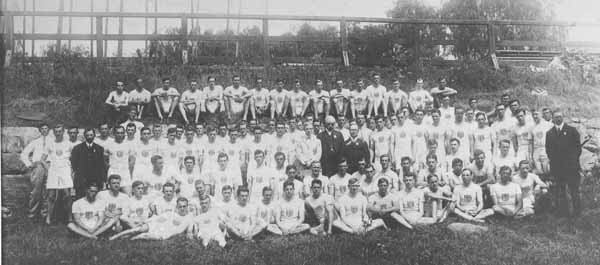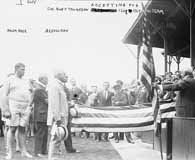A Very Different Olympic Games

The recently concluded, glitzy London Olympic games, with state of the art venues, world-wide television coverage, and dazzling opening and closing ceremonies were far different than the games of a century earlier.
The 1912 Olympic games were held in Stockholm, Sweden and were officially called the Games of the V Olympiad. Instead of the now traditional seventeen-day event, the 1912 games took place over a period of nearly three months. Although the games officially opened on July 6, they actually began as early as May 5, and ended on July 27.
{default}Unlike today when major international cities compete vigorously to host the summer Olympics, in 1912 Stockholm was the only city to have bid on the games three years earlier.
In 1912 the competition was considerably different. Although it consisted of 102 events in fourteen different sports that included: athletics, cycling, fencing, soccer, gymnastics, diving, equestrian, rowing, sailing, shooting, tennis, swimming, water polo, wrestling, and the modern pentathlon, there were also several competitions that have long since disappeared from the modern games. They included the tug of war and art competitions such as sculpture, painting, music, architecture and literature – all of which were judged and medals awarded. One of the contestants who won a gold medal in 1912 for literature was none other than the founder of the modern games and the then President of the IOC, Baron Pierre de Coubertin, who competed under several German nom de plumes.
By comparison, the 2012 games consisted of 26 different sports in 39 different disciplines. Sports such as basketball, field hockey, soccer, handball, judo, taekwondo, table tennis and badminton were either unknown or not part of the 1912 games.
 Unlike the 2012 Olympics, which were represented by 10,500 athletes from 204 nations, the approximately 2,400 competitors from twenty-eight nations in 1912 came primarily from North America and Europe, and Chile, Egypt, South Africa, Japan, and Australia.
Unlike the 2012 Olympics, which were represented by 10,500 athletes from 204 nations, the approximately 2,400 competitors from twenty-eight nations in 1912 came primarily from North America and Europe, and Chile, Egypt, South Africa, Japan, and Australia.
The cost of the games in 1912 was minimal compared to the billions invested in 2012. Nor was security an issue compared to the massive numbers involved in a post-9/11 world.
To win a gold medal in 1912 was to possess the real thing. It was the last Olympic games in which the medals were actually made of solid gold, and are worth a fortune in today’s gold prices.
Nor did the participants in 1912 undertake the sophisticated training that today’s athletes practice. There was neither the months and years of training that routinely occur today nor the preoccupation by so many nations to win medals. While in 1912 there was certainly vigorous competition, there was not the excessive nationalism and emphasis placed on winning that we see today. Moreover, the modern cynicism that blurs any distinction between amateur and professional athletes did not exist a century ago.
Sixteen years earlier a young French educator and sportsman, Baron Pierre de Coubertin, had resurrected the ancient Olympic games, which had fallen into disrepute under the Romans in the 4th Century. In its new, modern form de Coubertin visualized the Olympics promoting international goodwill by means of amateur competition on the athletic field. His vision of a modern Olympics became a reality in 1896 when he managed to induce nine nations to send 100 of their sportsmen to Athens to compete in the first games with 200 Greeks as a celebration of the highest in amateur athleticism.
 The Fifth Olympiad in 1912 would become the largest and most successful of the revived modern games. The twenty-eight nations represented included women who competed in swimming events.
The Fifth Olympiad in 1912 would become the largest and most successful of the revived modern games. The twenty-eight nations represented included women who competed in swimming events.
For the first time one of the main events of the games was the Modern Pentathlon, a new version of the original Greek competition in which soldier-athletes vied against one another in five events: swimming 300 meters, pistol shooting on a 25-meter range, running a grueling 4,000 meter (2-1/2 mile) course, fencing, and riding a 5,000 meter steeplechase.
Steeplechasing is a horse race in which horse and rider must jump a series of obstacles, usually in the form of fences and ditches. The Stockholm course consisted of 25 jumps and some 50 other impediments in the form of single and double drainage ditches and fallen logs over rock-strewn hills and forests north of the city. The ditches were from three to four feet deep and about two feet wide and were covered with grass, thus rendering them almost invisible. The riders were permitted to walk the course three days before the event and had to memorize the layout. Horse and rider only saw the course for the first time together during the actual event, a practice that exists to this day. In 1912, one Dane broke most of his ribs in a fall and seven others fell at one or more of the double ditches, which were situated a mere fourteen feet apart.
The original pentathlon had consisted of a javelin and discus throw, a mile run, a standing broad jump, a mile run and some form of wrestling, all of which were designed to demonstrate the abilities of the perfect Greek soldier.
The 1912 competition was limited to military contestants and when U.S. Army officials began considering their representative, a young lieutenant stationed at Fort Myer, Virginia, named George S. Patton immediately became virtually the only candidate considered. At West Point Patton had been a runner, his riding and swordsmanship were well known and since early childhood he had learned to shoot, and to swim long distances in the waters off Catalina Island in Southern California.
In that era there were no Olympic trials or biannual international competitions where athletes could vie for a berth on their national team. Instead, appropriate entrants were sought and invited to participate. Each athlete then devised and carried out his own training program to prepare for the games. Patton was the first U.S. Army officer to represent the United States in the Modern Pentathlon. However, he was not named to the US Olympic team until May 10, 1912, leaving precious little time for training for the games.
As Patton later wrote of the experience, he “was in excellent physical condition but had not run for about two years nor done any fast swimming for three.â€
 His arduous training regimen began immediately and brought untold misery to both Patton and his family. As daughter Ruth Ellen relates, “it was hard on everyone. He went on a diet of raw steak and salad and was, according to Ma, unfit for human companionship. But he had to push himself as he had such a short time in which to get into shape.â€
His arduous training regimen began immediately and brought untold misery to both Patton and his family. As daughter Ruth Ellen relates, “it was hard on everyone. He went on a diet of raw steak and salad and was, according to Ma, unfit for human companionship. But he had to push himself as he had such a short time in which to get into shape.â€
When George Patton trained for an athletic event, he was, as his nephew Fred Ayer has related, about as pleasant to be around as “a tiger from whose jaws a haunch of game has just been snatched.†He gave up alcohol and tobacco and punished himself brutally in swimming and running, his two weakest events. Patton knew only one way to train and that was unmercifully and without regard for himself or his safety. It was all the more difficult because he was not a natural athlete, had shown himself to be accident prone, struggled to run well and, in reality, loathed swimming, perpetually disdaining it as a sport.
Yet the fires of ambition and dyslexia burned as deeply within Patton as they had at West Point and the Olympics presented a splendid opportunity for him to show what he could do on a world stage. All else was secondary.
There was no respite when the US team and the Patton clan embarked aboard the steamship Finland June 14 for Antwerp. Accompanied by his wife, parents and sister Nita, Patton continued his training during the voyage.
He practiced swordsmanship and running with the rest of the team, a regimen that began at dawn and included runs of two miles around the decks of the Finland,and pistol practice at targets rigged off the fantail. To accommodate the swimming team a special twenty-foot long canvas pool was installed on the deck. Patton swam in place with a rope tied around his waist that left raw chafe marks.
The Pattons arrived in Sweden on June 29, where they were well received and fell in love with the nation and her hospitable people. In addition to continuing his rigorous training, Patton and his family were immediately caught up in an exciting round of parties, some of which were attended by the Royal family. Both George and his sister, Nita, were often mistaken for Nordics, and it was at one of these events that Patton met the aide to King Gustavus V, a colonel named Bjorling. The two men became life-long friends and the last photograph of Patton taken before his death in 1945 was with his Swedish friend.
Patton’s father accompanied his son to each practice and was ever-present to render encouragement. He also quickly became a favorite of the Swedish officers who adored him. One evening Mr. Patton unintentionally sat down at a table outside a hotel that was reserved for members of a select club. An angry member strode up and insultingly placed his cane on the table in front of the startled Patton. Instantly a Swedish officer who knew him leapt from a nearby chair, broke the cane in half, apologized, and brought him to his own table.
When the games officially opened on July 5, 1912, George S. Patton would be physically and mentally tested in ways he never could have imagined.
Next month the story of Patton and the Modern Pentathlon – and how history was nearly made.


0 Comments
Trackbacks/Pingbacks